coolant temperature CHEVROLET ASTRO 1996 Owners Manual
[x] Cancel search | Manufacturer: CHEVROLET, Model Year: 1996, Model line: ASTRO, Model: CHEVROLET ASTRO 1996Pages: 372, PDF Size: 21.51 MB
Page 77 of 372
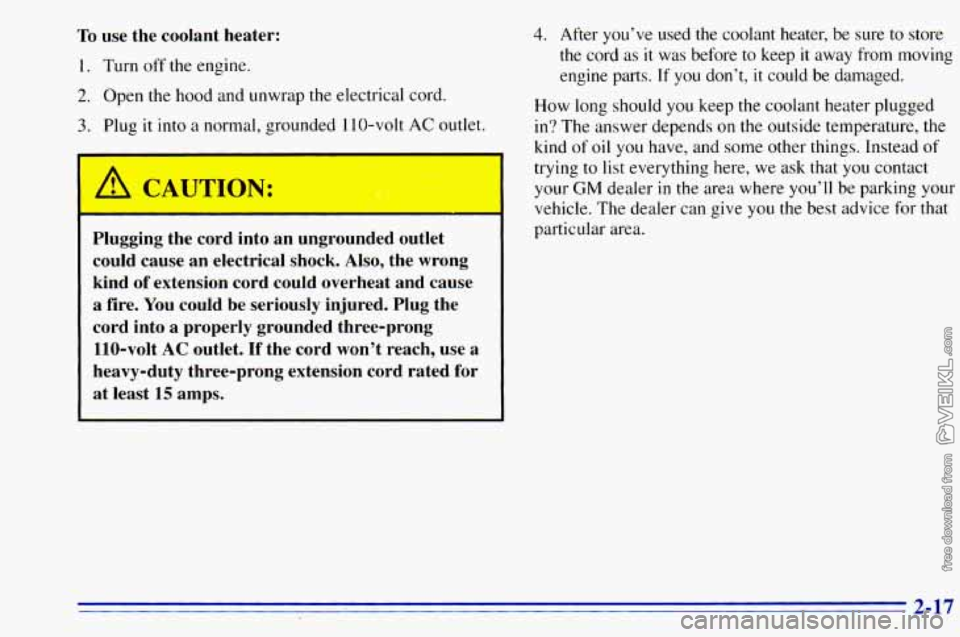
To use the coolant heater:
1. Turn off the engine.
2. Open the hood and unwrap the electrical cord.
3. Plug it into a normal, grounded 110-volt AC outlet.
I
Plugging the cord into an ungrounded outlet
could cause an electrical shock. Also, the wrong
kind of extension cord could overheat and cause
a fire. You could be seriously injured. Plug the
cord into
a properly grounded three-prong
110-volt AC outlet. If the cord won’t reach, use
a
heavy-duty three-prong extension cord rated for
at least 15 amps.
4. After you’ve used the coolant heater, be sure to store
the cord
as it was before to keep it away from moving
engine parts.
If you don’t, it could be damaged.
How long should you keep the coolant heater plugged
in? The answer depends on the outside temperature, the
kind
of oil you have, and some other things. Instead of
trying
to list everything here, we ask that you contact
your
GM dealer in the area where you’ll be parking your
vehicle. The dealer can give
you the best advice for that
particular area.
2-17
Page 122 of 372
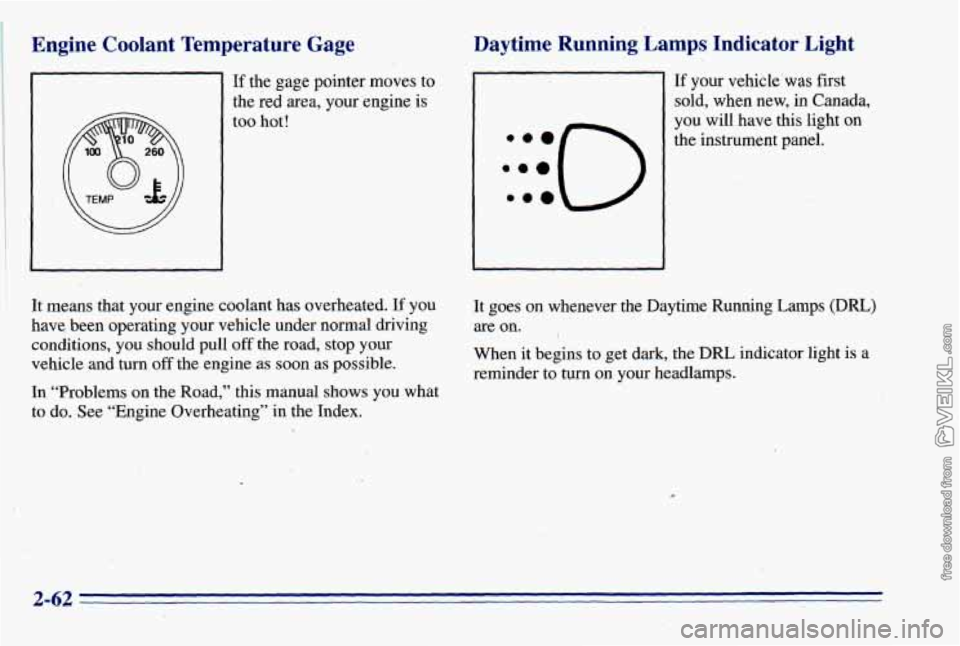
Engine Coolant Temperature Gage
If the gage pointer moves to
the red area, your engine is
too hot!
Daytime Running. Lamps, Indicator Light
:::O ..e
If your vehicle’was first
sold, when new, in Canada,
you will have this light on
the instrument panel.
It means that your engine coolant has overheated.
If you
have been operating your vehicle under normal driving
conditions, you should pull
off the road, stop your
vehicle and turn
off the engine as soon as possible. It goes
on whenever the Daytime Running Lamps (DRL)
are on. I
When it begins
to get dark, the DRL indicator light is a
reminder to
turn on your headlamps.
In “Problems on the Road,”
this manual shows you what
to do. See “Engine’Overheating” in the Index.
2-62
Page 129 of 372

Air Conditioning
Before using your vehicle’s air conditioning, open the
windows to clear the vehicle of hot air. This reduces the
time it takes for your vehicle to cool down. Then keep
your windows closed for the air conditioner to work at
its best.
You can use MAX A/C with the temperature knob in the
blue area, when it’s really hot outside and you need to
cool the inside air quickly. MAX A/C lets
in only a little
air from the outside.
If you first use MAX A/C, you can then use A/C
with
the temperature knob in the blue area, as soon as the
vehicle has cooled down,
so outside air will be going
through your vehicle.
If your vehicle has rear air conditioning, setting
it on LO
may enhance the front A/C performance by allowing
trapped refrigerant in the rear lines to circulate. The
rear air conditioning system will only send cooled
air if the front system is on. It can still be used to
circulate air, even if the front system is off.
When the air conditioning, DEFROST or BLEND is on,
you may notice a slight increase or decrease
in engine
speed, due to compressor operation. This is normal
because
the system is designed to cycle the compressor
on and off to keep the desired temperature.
Heating
On cold days, use HEATER with the temperature knob
in the red area. Outside air will be brought in through
the floor outlets. The heater works best
if you keep your
windows closed while using it.
If you use the optional engine coolant heater before
starting your engine, your heating system will produce
warmer air faster to heat the passenger compartment in
cold weather. See “Engine Coolant Heater”
in the Index.
3-5
Page 189 of 372
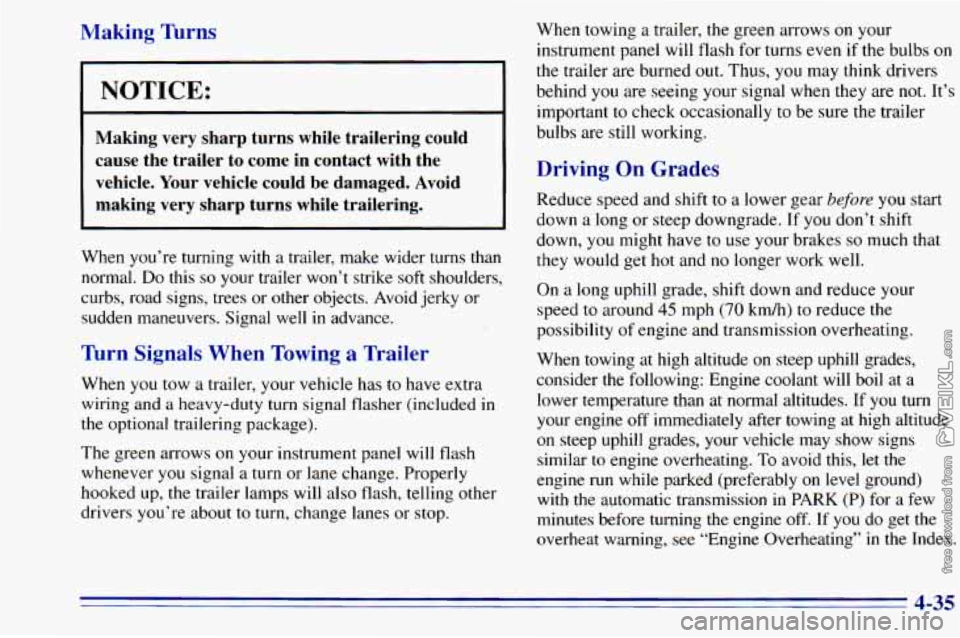
Making Turns
NOTICE:
Making very sharp turns while trailering could
cause the trailer to come in contact with the
vehicle. Your vehicle could
be damaged. Avoid
making very sharp turns while trailering.
When you’re turning with a trailer, make wider turns than
normal.
Do this so your trailer won’t strike soft shoulders,
curbs, road signs, trees or other objects. Avoid jerky or
sudden maneuvers. Signal well in advance.
Tbrn Signals When Towing a Trailer
When you tow a trailer, your vehicle has to have extra
wiring and a heavy-duty turn signal flasher (included
in
the optional trailering package).
The green arrows on your instrument panel will flash
whenever you signal a turn or lane change. Properly
hooked up, the trailer lamps will also flash, telling other
drivers you’re about to turn, change lanes or stop. When
towing
a trailer, the green arrows on your
instrument panel will flash for turns even if the bulbs
on
the trailer are burned out. Thus, you may think drivers
behind you are seeing your signal when they are not. It’s
important
to check occasionally to be sure the trailer
bulbs are still working.
Driving On Grades
Reduce speed and shift to a lower gear before you start
down a long or steep downgrade. If
you don’t shift
down, you might have to use your brakes
so much that
they would get hot and
no longer work well.
On a long uphill grade, shift down and reduce your
speed to around
45 mph (70 km/h) to reduce the
possibility
of engine and transmission overheating.
When towing at high altitude on steep uphill grades,
consider the following: Engine coolant will boil at a
lower temperature than at normal altitudes. If you turn
your engine off immediately after towing at high altitude
on steep uphill grades, your vehicle may show signs
similar to engine overheating.
To avoid this, let the
engine run while parked (preferably on level ground)
with the automatic transmission in
PARK (P) for a few
minutes before turning
the engine off. If you do get the
overheat warning, see “Engine Overheating” in
the Index.
4-35
Page 205 of 372
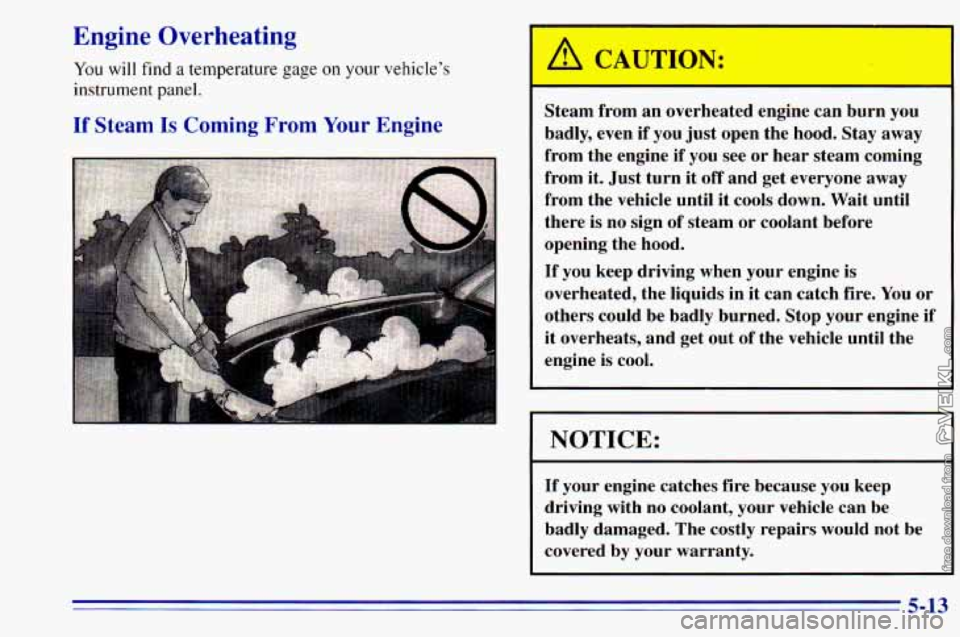
Engine Overheating
You will find a temperature gage on your vehicle’s
instrument panel.
If Steam Is Coming From Your Engine
Steam from an overheated engine can burn you
badly, even if you just open the hood.
Stay away
from the engine if you see or hear steam coming
from it. Just turn it off and get everyone away
from the vehicle until it cools down. Wait until
there is no sign of steam or coolant before
opening the hood.
If you keep driving when your engine is
overheated, the liquids in it can catch fire. You or
others could be badly burned. Stop your engine if
it overheats, and get out of the vehicle until the
engine is cool.
I NOTICE:
If your engine catches fire because you keep
driving with no coolant, your vehicle can be
badly damaged. The costly repairs would not be
covered by your warranty.
5-13
Page 255 of 372
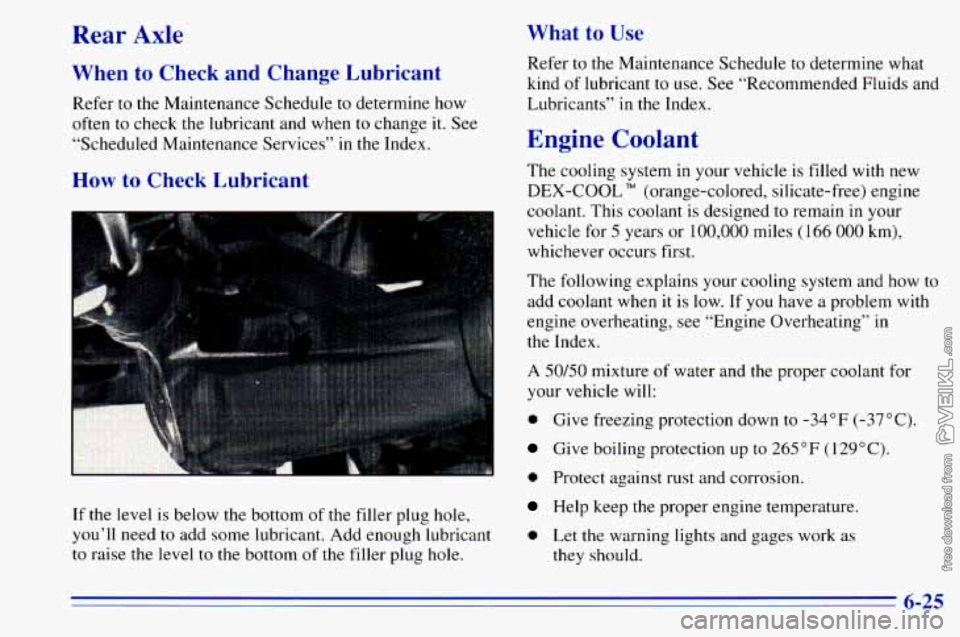
What to Use Rear Axle
When to Check and Change Lubricant
Refer to the Maintenance Schedule to determine how
often to check the lubricant and when
to change it. See
“Scheduled Maintenance Services” in the Index.
How to Check Lubricant
If the level is below the bottom of the filler plug hole,
you’ll need to add some lubricant. Add enough lubricant
to raise the level to the bottom of the filler plug hole. Refer
to the Maintenance Schedule to determine what
kind of lubricant
to use. See “Recommended Fluids and
Lubricants” in the Index.
Engine Coolant
The cooling system in your vehicle is filled with new
DEX-COOL (orange-colored, silicate-free) engine
coolant. This coolant is designed to remain in your
vehicle for
5 years or 100,000 miles (166 000 km),
whichever occurs first.
The following explains your cooling system and how to
add coolant when it is low. If
you have a problem with
engine overheating, see “Engine Overheating’’ in
the Index.
A 50/50 mixture of water and the proper coolant for
your vehicle will:
0 Give freezing protection down to -34°F (-37°C).
Give boiling protection up to 265 “F (1 29°C).
0 Protect against rust and corrosion.
Help keep the proper engine temperature.
0 Let the warning lights and gages work as
they should.
6-25
Page 260 of 372
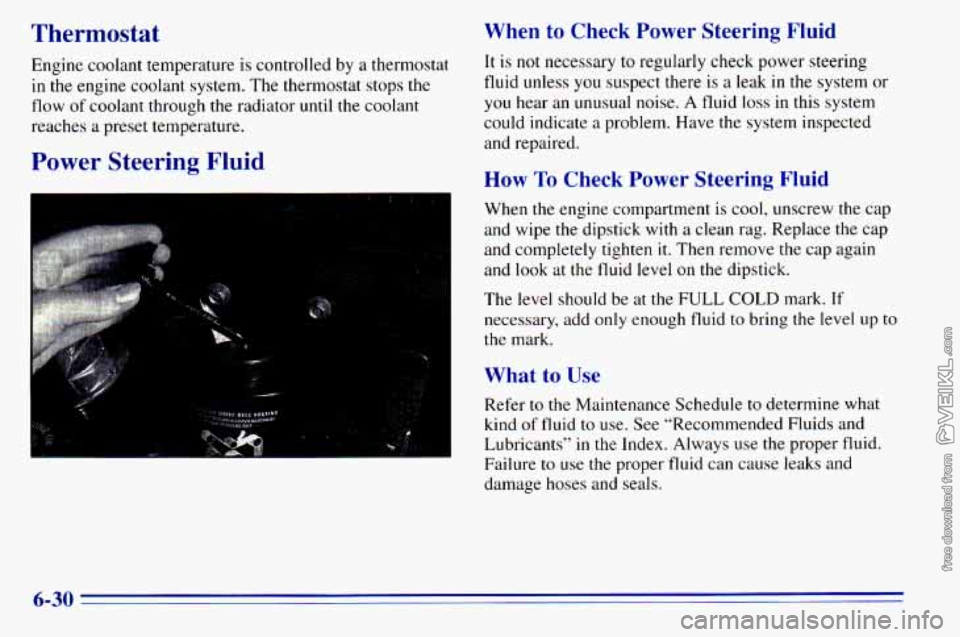
Thermostat When to Check Power Steering Fluid
Engine coolant temperature is controlled by a thermostat It is not necessary to reg,ularlY check Power steering
in the engine coolant system. The thermostat stops the fluid unless you suspect there is a leak in the system or
flow
of coolant through the radiator until the coolant you
hear an unusual noise. A fluid loss in this system
reaches a preset temperature. could indicate
a problem. Have the system inspected
and remired.
Power Steering Fluid
I
How To Check Power Steering Fluid
When the engine compartment is cool, unscrew the cap
and wipe
the dipstick with a clean rag. Replace the cap
and completely tighten
it. Then remove the cap again
and look at the fluid level
on the dipstick.
The level should be at the
FULL COLD mark. If
necessary, add only enough fluid to bring the level up to
the mark.
What to Use
Refer to the Maintenance Schedule to determine what
kind
of fluid to use. See “Recommended Fluids and
Lubricants’’
in the Index. Always use the proper fluid.
Failure to use the proper fluid can cause leaks and
damage hoses and seals.
6-30
Page 363 of 372
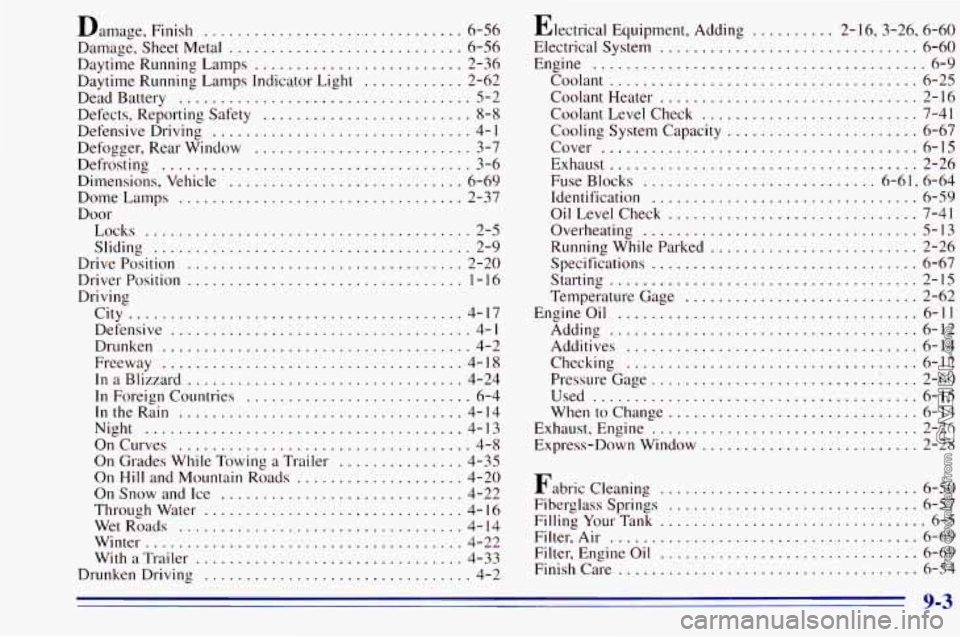
Damage. Finish ........................ . . 6-56
Damage. Sheet Metal
............................ 6-56
Daytime Running Lamps
......................... 2-36
Daytime Running Lamps Indicator Light
............ 2-62
Dead Battery
................................... 5-2
Defects. Reporting Safety
......................... 8-8
Defensive Driving ............................... 4- 1
Defogger. Rear Window .......................... 3-7
Defrosting
..................................... 3-6
Dimensions. Vehicle
............................ 6-69
Dome Lamps
.................................. 2-37
Door Locks
....................................... 2-5
Sliding ...................................... 2-9
DrivePosition
................................. 2-20
DriverPosition
................................. 1-16
Driving City
........................................ 4-17
Defensive
.................................... 4-1
Drunken ..................................... 4-2
Freeway
.................................... 4-18
InaBlizzard ................................. 4-24
In Foreign Countries ........................... 6-4
In the Rain .................................. 4-14
Night
...................................... 4-13
OnCurves
................................... 4-8
On Grades While Towing
a Trailer ............... 4-35
On Hill and Mountain Roads
.................... 4-20
On Snow and Ice
............................. 4-22
Through Water
................... ....... 4-16
WetRoads
.................................. 4-14
Winter ...................................... 4-22
With a Trailer ................................ 4-33
Drunken Driving
................................ 4-2 Electrical
Equipment. Adding
........ 2- 16. 3.26. 6-60
Electrical System
............................... 6-60
Engine ........................................ 4-9
Coolant
..................................... 6-25
Coolant Heater
............................... 2-16
Coolant Level Check
.......................... 7-41
Cooling System Capacity
....................... 6-67
Cover
...................................... 6-15
Exhaust
..................................... 2-26
FuseBlocks
............................ 6-61. 6-64
Identification
................................ 6-59
OilLevelCheck
.............................. 7-41
Overheating
................................. 5-13
Running While Parked
......................... 2-26
Specifications
................................ 6-67
Starting
..................................... 2-15
Temperature Gage
............................ 2-62
Engineoil
.................................... 6-11
Adding
..................................... 6-12
Additives
................................... 6-14
Checking
................................... 6-12
Pressure Gage
........................... .... 2-60
Used
....................................... 6-15
Whentochange .............................. 6-14
Exhaust. Engine
................................ 2-26
Express-Down Window
........................ 2-28
Fabric Cleaning
............................... 6-50
Fiberglass Springs
.............................. 6-57
Filling Your Tank
................................ 6-5
Filter. Air
..................................... 6-69
Filter. Engine Oil
............................... 6-69
Finish Care
.................................... 6-54
9-3
Page 364 of 372
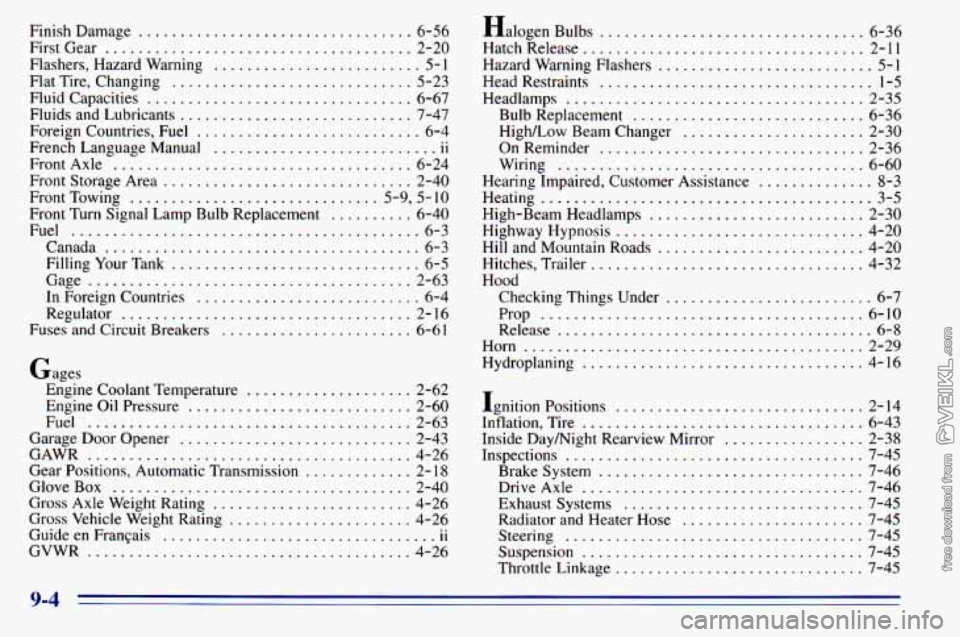
Finish Damage ................................. 6-56
First Gear
..................................... 2-20
Flashers. Hazard Warning
......................... 5-1
Flat Tire. Changing ............................. 5-23
Fluid Capacities
................................ 6-67
Fluids and Lubricants
............................ 7-47
Foreign Countries. Fuel
........................... 6-4
French Language Manual
11
Front Axle .................................... 6-24
Front Storage Area
.............................. 2-40
Front Towing
.............................. 5-9. 5- 10
Front Turn Signal Lamp Bulb Replacement .......... 6-40
Fuel
.......................................... 6-3
Canada
...................................... 6-3
Filling Your Tank
.............................. 6-5
Gage
....................................... 2-63
In Foreign Countries
........................... 6-4
Regulator
................................... 2-16
Fuses
and Circuit Breakers ....................... 6-61
Gages
.. ...........................
Engine Coolant Temperature .................... 2-62
Engine Oil Pressure
........................... 2-60
Fuel
....................................... 2-63
Garage Door Opener
............................ 2-43
Gear Positions. Automatic Transmission
............. 2- 18
GloveBox .................................... 2-40
Gross Axle Weight Rating
........................ 4-26
Gross Vehicle Weight Rating
...................... 4-26
Guide en FranGais
11
GVWR ....................................... 4-26
GAWR
....................................... 4-26
.. .................................
Halogen
Bulbs ................................ 6-36
Hatch Release
.................................. 2-11
Hazard Warning Flashers .......................... 5-1
Head Restraints ................................. 1-5
Headlamps .................................... 2-35
Bulb Replacement
............................ 6-36
Highkow Beam Changer
...................... 2-30
OnReminder
................................ 2-36
Wiring
..................................... 6-60
Hearing Impaired. Customer Assistance
.............. 8-3
Heating ........................................ 3-5
High-Beam Headlamps
.......................... 2-30
Highway Hypnosis
.............................. 4-20
Hill and Mountain Roads
......................... 4-20
Hitches. Trailer
................................. 4-32
Hood Checking Things Under
......................... 6-7
Prop
....................................... 6-10
Release
...................................... 6-8
Horn
......................................... 2-29
Hydroplaning
.................................. 4-16
Ignition Positions
.............................. 2-14
Inflation. Tire
.................................. 6-43
Inside Daymight Rearview Mirror
................. 2-38
Inspections
.................................... 7-45
Brakesystem
................................ 7-46
Drive Axle
.................................. 7-46
Exhaust Systems
............................. 7-45
Radiator and Heater Hose
...................... 7-45
Steering
.................................... 7-45
Suspension
.................................. 7-45
Throttle Linkage
.............................. 7-45
9-4